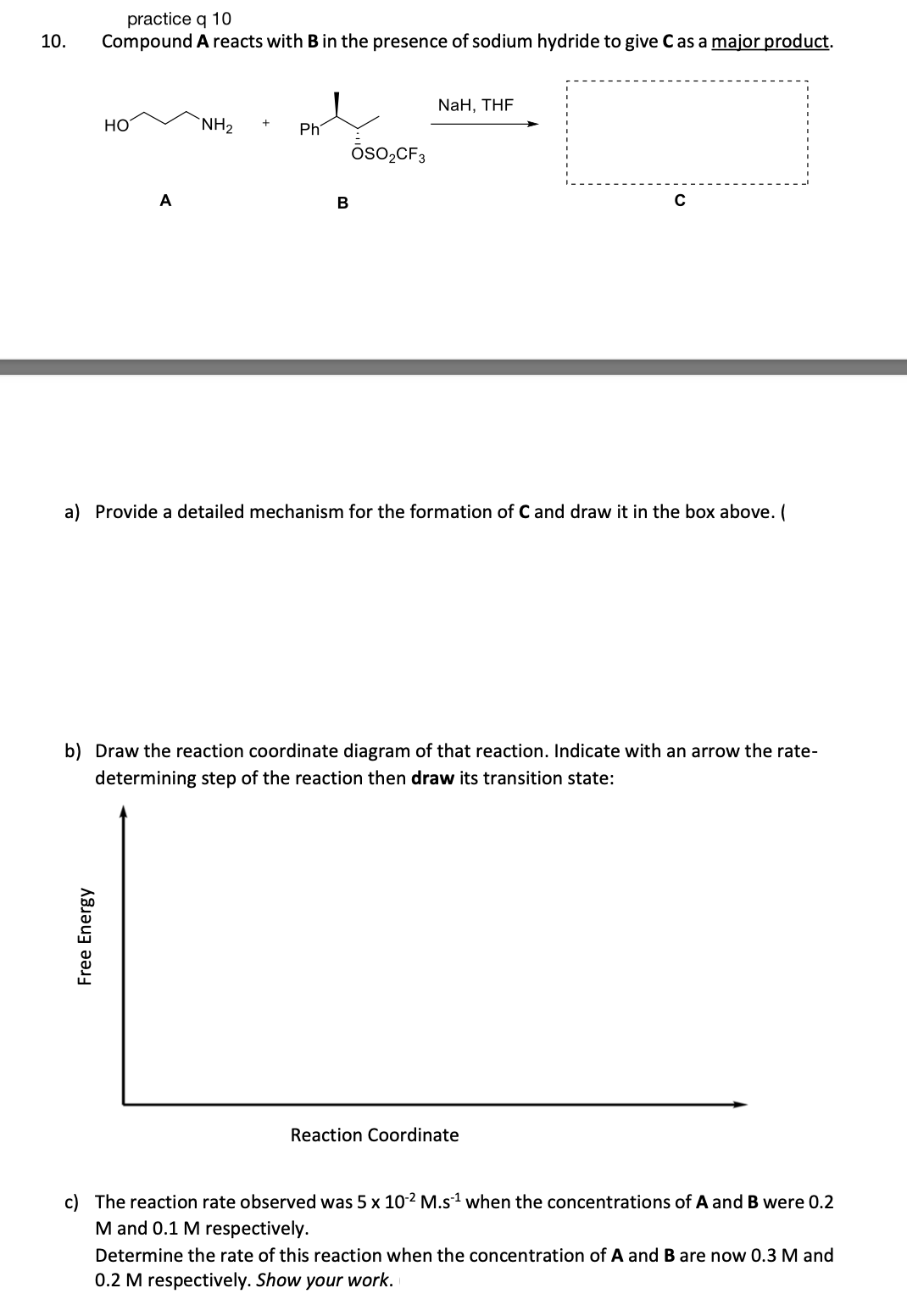0. Compound A reacts with B in the presence of sodium hydride to give C as a major product. HO A Free Energy NH₂ Ph B ŌSO₂CF3 NaH, THF a) Provide a detailed mechanism for the formation of C and draw it in the box above. ( C b) Draw the reaction coordinate diagram of that reaction. Indicate with an arrow the rate- determining step of the reaction then draw its transition state: Reaction Coordinate The reaction rate observed was 5 x 10-2 M.s¹ when the concentrations of A and B were 0.2 M and 0.1 M respectively. Determine the rate of this reaction when the concentration of A and B are now 0.3 M and 0.2 M respectively. Show your work.
0. Compound A reacts with B in the presence of sodium hydride to give C as a major product. HO A Free Energy NH₂ Ph B ŌSO₂CF3 NaH, THF a) Provide a detailed mechanism for the formation of C and draw it in the box above. ( C b) Draw the reaction coordinate diagram of that reaction. Indicate with an arrow the rate- determining step of the reaction then draw its transition state: Reaction Coordinate The reaction rate observed was 5 x 10-2 M.s¹ when the concentrations of A and B were 0.2 M and 0.1 M respectively. Determine the rate of this reaction when the concentration of A and B are now 0.3 M and 0.2 M respectively. Show your work.
Organic Chemistry: A Guided Inquiry
2nd Edition
ISBN:9780618974122
Author:Andrei Straumanis
Publisher:Andrei Straumanis
Chapter13: Substitution
Section: Chapter Questions
Problem 43CTQ
Related questions
Question

Transcribed Image Text:10.
practice q 10
Compound
Free Energy
HO
A
A reacts with B in the presence of sodium hydride to give C as a major product.
NH₂
Ph
B
ŌSO₂CF3
NaH, THF
a) Provide a detailed mechanism for the formation of C and draw it in the box above. (
C
b) Draw the reaction coordinate diagram of that reaction. Indicate with an arrow the rate-
determining step of the reaction then draw its transition state:
Reaction Coordinate
c) The reaction rate observed was 5 x 10-2 M.s¹ when the concentrations of A and B were 0.2
M and 0.1 M respectively.
Determine the rate of this reaction when the concentration of A and B are now 0.3 M and
0.2 M respectively. Show your work.
Expert Solution
This question has been solved!
Explore an expertly crafted, step-by-step solution for a thorough understanding of key concepts.
Step by step
Solved in 4 steps with 4 images

Knowledge Booster
Learn more about
Need a deep-dive on the concept behind this application? Look no further. Learn more about this topic, chemistry and related others by exploring similar questions and additional content below.Recommended textbooks for you

Organic Chemistry: A Guided Inquiry
Chemistry
ISBN:
9780618974122
Author:
Andrei Straumanis
Publisher:
Cengage Learning

Organic Chemistry: A Guided Inquiry
Chemistry
ISBN:
9780618974122
Author:
Andrei Straumanis
Publisher:
Cengage Learning